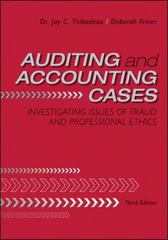FOF incorporated FOF Proprietary Funds, Ltd. (FOF Prop) as an umbrella for specialized investment accounts that were
Question:
FOF incorporated FOF Proprietary Funds, Ltd. (FOF Prop) as an umbrella for specialized investment accounts that were managed by its investment advisers.
One of these accounts was the National Resources Fund Account (NRFA), which was dedicated to investments in oil, gas, and mineral assets. Although no formal written agreement established King Resources Corporation (KRC) as the investment adviser for the NRFA, FOF’s clear intent was to use KRC’s expertise to locate and purchase speculative natural resource investments. FOF had no means of independently valuing the assets proposed by KRC for investment.
FOF was required to value its investment portfolio daily because the company redeemed shares on the basis of its daily share value. The daily share value was determined by dividing the net asset value of FOF’s entire portfolio by the number of outstanding shares. FOF relied on the advice of KRC for the revaluations of its natural resource assets contained in the NRFA. Because of its speculative nature and the lack of an active trading market, determining the value of its natural resource interests was very difficult.2 Fox–Raff In late 1968 KRC’s founder and owner John King arranged a deal with Robert Raff, president of a Seattle brokerage firm, whereby Raff would purchase 10 percent of a specific natural resource interest that was owned by FOF. The sale was designed to provide a basis for the revaluation of FOF’s remaining 90 percent interest in the natural resource interest. The purchase price for Raff’s 10 percent interest totaled \($440,000,\) with an \($88,000\) down payment required. The transaction provided a basis for FOF to write up the valuation of its 90 percent interest in the specific natural resource interest by \($820,000\).
To execute the deal, King actually advanced Raff all of the money that was needed to make the down payment, assuring Raff that no further financial commitment was necessary. Raff intended to sell the investment within six months so that he would never have to meet the remaining financial obligations to FOF. When FOF pressed for payment, KRC would provide Raff with the means to pay.
Andersen’s auditors questioned whether the 10 percent sale was sufficient enough to establish the value of the whole parcel. They also questioned the basis for the write-up due to the short holding period for the natural resource interest, as well as the lack of any oil strikes or any new geological information that would justify the revaluation of the parcel. Arthur Andersen resolved to express these concerns in a letter to the board of directors of FOF—but ultimately never sent such a letter. The Arthur Andersen partner working on the year-end 1968 FOF audit, John Robinson, told Edward Cowett, the COO of FOF, that Andersen could accept the Fox–Raff transaction as a basis for revaluation only because it was immaterial to the financial statements as a whole.
Development of Guidelines for Revaluation3 In the fall of 1969 Andersen sought to establish guidelines for unrealized appreciation or revaluations to allow for “substantive independent evidence for reviewing the reasonableness of the client’s valuations.” A November 7, 1969, memorandum set out Arthur Andersen’s proposal: Any significant increase in the value of natural resource properties over original cost to FOF must, for audit purposes, be supported by either (1) an appraisal report rendered by a competent, independent expert, or (2) an arms-length [sic] sale of a sufficiently large enough portion of a property to establish a proportionate value for the portion retained. . . .
On the question of what constitutes adequate sales data for valuation purposes (i.e., the 10% question), we have proposed the following to King Resources Company:
1. No unrealized appreciation would be allowed on sales of relatively small percentages of properties to private investors or others who do not have the necessary expertise to determine a realistic fair market value. By “relatively small,” we envision approximately 50% as being a minimum level in this type of sale to establish proportionate values for the remaining interests. This would preclude any unrealized appreciation on sales such as the December, 1968, sales to Fox–Roff, [sic] Inc. since it could not be reasonably sustained that a brokerage firm has the expertise necessary to evaluate primarily undeveloped resource interests.
2. Appreciation would be allowed if supported by arms-length [sic] sales to knowledgeable outside parties. For example, if King Resources Company sold a 25% interest in the Arctic permits to Texaco or another major oil company, we believe it would be appropriate to ascribe proportionate value to the 75%
retained. Just where to draw the line on the percentage has not been clearly established. We feel 10% would be a bare minimum and would like to see a higher number. . . .
Case Questions
1. Consider the principles, assumptions, and constraints of Generally Accepted Accounting Principles (GAAP). Define the conservatism constraint and explain why it is important to users of financial statements.
2. Explain specifically why FOF’s decision to record substantial increases in its natural resource assets violated the conservatism constraint.
3. Do you believe that FOF established an effective system of internal control over financial reporting related to the valuation of its natural resource assets? Why or why not?
4. Consider the valuation assertion related to the natural resources assets. Do you think it is reasonable for an auditor to rely on a recent sale of a 10 percent interest as evidence to justify a revaluation of FOF’s remaining 90 percent interest in the natural resource assets? Why or why not?
5. What other evidence could an auditor seek to justify the valuation of an asset where there is no active trading market? Comment on whether Arthur Andersen’s guidelines for the appreciation of national resource properties were appropriate under the circumstances. Why or why not?
Step by Step Answer:

Auditing And Accounting Cases Investigating Issues Of Fraud And Professional Ethics
ISBN: 9780078110818
3rd Edition
Authors: Jay Thibodeau, Deborah Freier





